| Author |
Message |
|
Erin C.
|
 Posted: Wed 28 May, 2008 6:37 pm Post subject: Can you help me identify? Posted: Wed 28 May, 2008 6:37 pm Post subject: Can you help me identify? |
 |
|
This sword has been passed down through my grandmother's side, since her grandfather (or great-grandfather) plowed it up in his field in Scotland.
That's all the info. I have. I think it may be a beaknose ribbon hilt? Any idea of its age, maker, when it would have been used?
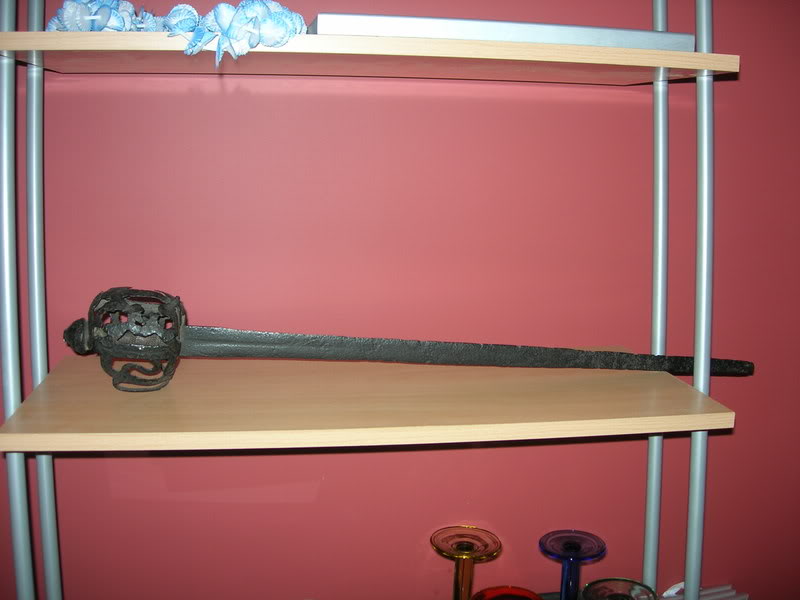
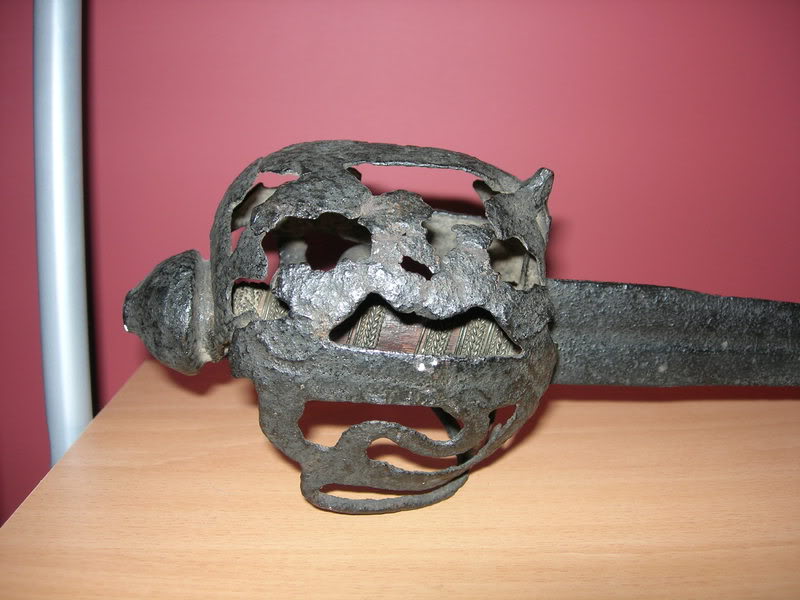
[/img]
|
|
  |
 |
|
Justin King
Industry Professional
|
 Posted: Wed 28 May, 2008 6:43 pm Post subject: Posted: Wed 28 May, 2008 6:43 pm Post subject: |
 |
|
|
Very interesting heirloom, Erin. I would agree with your thoughts but can't add much, you will likely get some much more informative answers soon. In any event thanks for sharing.
|
|
  |
 |
Nathan M Wuorio

|
 Posted: Wed 28 May, 2008 7:31 pm Post subject: Posted: Wed 28 May, 2008 7:31 pm Post subject: |
 |
|
Very beautiful sword, and a very lucky find. Maybe 18th century. The grip appears [to me] to still have some wrapping on it, and is there a particular design on the basket?
Nathan.
|
|
  |
 |
|
Erin C.
|
 Posted: Thu 29 May, 2008 6:34 am Post subject: Posted: Thu 29 May, 2008 6:34 am Post subject: |
 |
|
The only design part I can make out is the S motif on the side. Otherwise it is in pretty bad shape (the side not photographed looks worse than the side you can see). "S" for Stewart, perhaps?
Does anyone have pictures of swords that could look how this sword would have looked?
Thanks for your responses so far. :)
|
|
  |
 |
|
Jonathan Hopkins
|
 Posted: Thu 29 May, 2008 7:18 am Post subject: Posted: Thu 29 May, 2008 7:18 am Post subject: |
 |
|
I can try to get more info this evening, but tentatively I would say it is a 17th century Scottish ribbon hilt.
Jonathan
|
|
  |
 |
Christopher Gregg

|
 Posted: Thu 29 May, 2008 7:27 am Post subject: Scottish sword Posted: Thu 29 May, 2008 7:27 am Post subject: Scottish sword |
 |
|
Erin,
What you've got there is an early 17th century Scottish Beak-nose Ribbon-hilt Claymore (a basket-hilted broadsword favored by Highlanders). I'd estimate that it dates to somewhere between 1610 and 1640. It was probably made in Stirling, since it has the classic "S" shape on its side plate. I must say, you're pretty fortunate to have such a historical family heirloom! BTW, from my occasional perusings of antique sword dealer's web site, I'd say it's value is anywhere from $3000 - $6000. Hang onto it! :D
Christopher Gregg
'S Rioghal Mo Dhream!
|
|
  |
 |
|
Justin King
Industry Professional
|
 Posted: Thu 29 May, 2008 7:30 am Post subject: Posted: Thu 29 May, 2008 7:30 am Post subject: |
 |
|
I have a couple of books that show similar hilts but don't have a scanner so I can't post them here. The most similar dated hilts I am seeing are dated 1650-1670 or thereabouts.
The very large saltire plates and the rear-guards are the main distinctive traits among this type of hilt and are shared by yours as well. The examples I am looking at are in Cyril Mazansky's "British Basket Hilted Swords", groups C4 and C5 and variants, if you can get ahold of a copy, or perhaps find someone with the book and a scanner to post pics. Wish I could offer more help, hopefully someone else here has more resources (there are certainly those with more base knowledge of these swords than myself) that can provide pics of other examples.
|
|
  |
 |
Kirk Lee Spencer

|
 Posted: Thu 29 May, 2008 9:21 am Post subject: Posted: Thu 29 May, 2008 9:21 am Post subject: |
 |
|
| Erin C. wrote: | | ...Does anyone have pictures of swords that could look how this sword would have looked?... |
Hey Erin...
Here are a few.
(if you put the cursor over the image you can see the file name with a basic data set)
ks
 Attachment: 50.28 KB Attachment: 50.28 KB
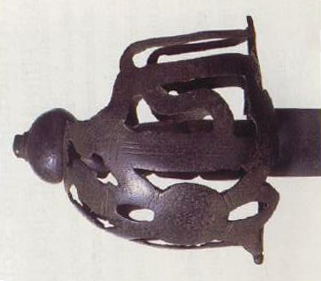
From Earlshall Castle Collection. Photo from Peter Finer Catalogue
 Attachment: 98.71 KB Attachment: 98.71 KB
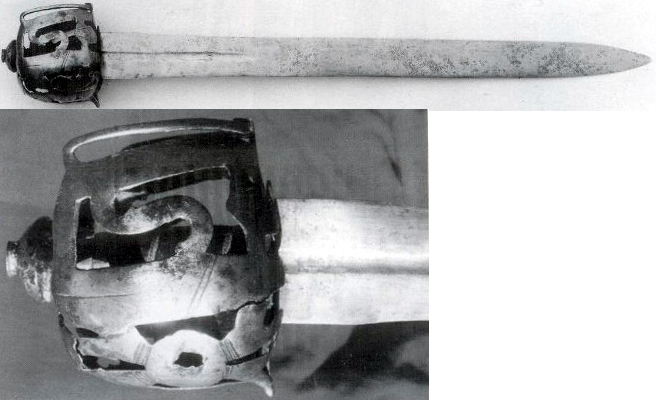
 Attachment: 68.94 KB Attachment: 68.94 KB
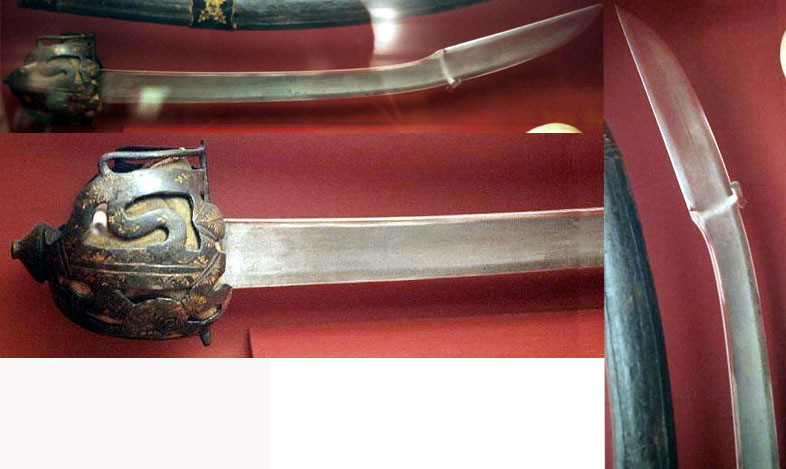
Image mosiac from photographs by Thomas McDonald
 Attachment: 56.73 KB Attachment: 56.73 KB
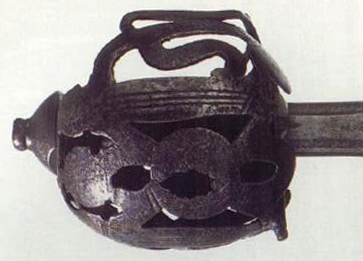
From Earlshall Castle Collection. Photo from Peter Finer Catalogue
 Attachment: 98.39 KB Attachment: 98.39 KB
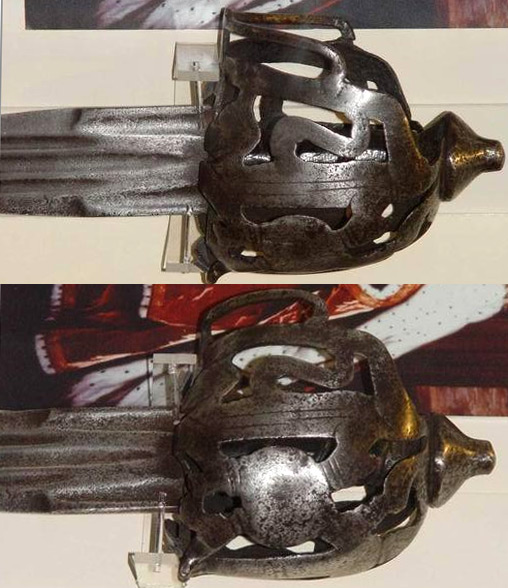
From National Museum of Antiquities, Edinburgh. Image mosic from photographs by Ron Luciano
 Attachment: 99.58 KB Attachment: 99.58 KB
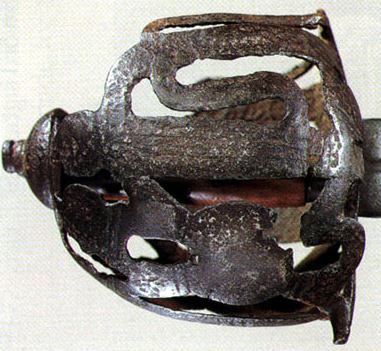
 Attachment: 99.46 KB Attachment: 99.46 KB
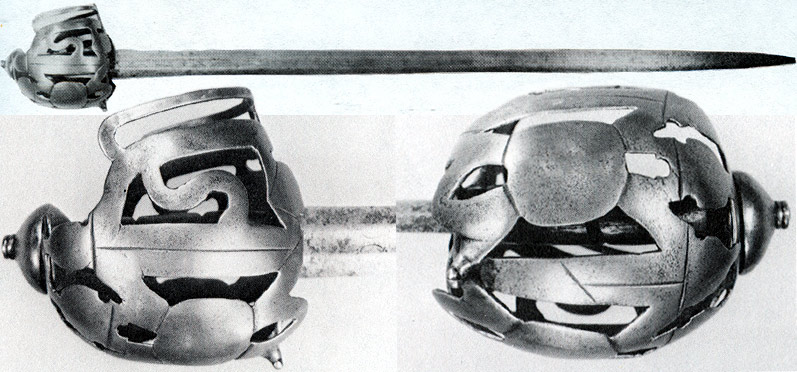
Image compiled from "Swords and Blades of the American Revolution by George C. Neumann
Two swords
Lit in Edenís flame
One of iron and one of ink
To place within a bloody hand
One of God or one of man
Our souls to one of
Two eternities
|
|
  |
 |
|
Erin C.
|
 Posted: Thu 29 May, 2008 9:30 am Post subject: Posted: Thu 29 May, 2008 9:30 am Post subject: |
 |
|
Thanks everyone! I do feel fortunate to have it, especially since it is unusual for an heirloom to be passed down through the maternal side, I think. However because of this fact, it has been difficult for me to trace the surname of my ancestor who found it, and unfortunately my grandmother's memory is not what it used to be.
Any ideas as to who would have used it? A soldier, or a regular guy? And were there particular regions in which this type were commonly used? (A long shot as I guess they were quite prevalent but it is worth a try).
Most importantly, any ideas on how I can preserve it best? Currently it is hanging horizontally on my basement wall (where visitors to the house are least likely to seize upon it and wreck it). The basement is a little humid, but not too bad. It has a lot of weight to it, but I worry that it is brittle as well, and I just about had a fit when we were moving house, trying to be so careful with it.
Thanks again to everyone who has commented.
|
|
  |
 |
|
Erin C.
|
 Posted: Thu 29 May, 2008 9:33 am Post subject: Posted: Thu 29 May, 2008 9:33 am Post subject: |
 |
|
|
Kirk! Thank you so much for posting the pictures! That is it! :surprised: :D
|
|
  |
 |
Thom R.

|
 Posted: Thu 29 May, 2008 9:55 am Post subject: Posted: Thu 29 May, 2008 9:55 am Post subject: |
 |
|
|
wow that does look to be an original circa 1600s, note how the blade curves rapidly right at the end of the ricasso - a classic marker for mid 17th c german blades. the one minor point of disagreement I would have is that we know that ribbon bars like this were made right through the 17th c into the williamite war, so I don't know that one can conclusively say 1610-1640 although I would agree with Stirling as a possible source. just could be later 17th c. the tip is quite rounded either by design or by later grinding/repair or loss of material from corrosion. are there any marks at all on the blade? the one strange thing I note in your photo is the grip. the wire and wood grip look amazingly intact and uncorroded in comparison to the steel - are they modern replacements, did you clean the wire on the grip? is the wood grip reeded or carved in anyway? where was this found? tell us more! very nice sword.
|
|
  |
 |
|
Erin C.
|
 Posted: Thu 29 May, 2008 10:36 am Post subject: Posted: Thu 29 May, 2008 10:36 am Post subject: |
 |
|
| Thom R. wrote: | | are there any marks at all on the blade? the one strange thing I note in your photo is the grip. the wire and wood grip look amazingly intact and uncorroded in comparison to the steel - are they modern replacements, did you clean the wire on the grip? is the wood grip reeded or carved in anyway? where was this found? tell us more! very nice sword. |
I will have to look closer for marks on the blade. It is badly corroded though, so I doubt I will find any.
The grip is amazingly intact, as are the wires, and I have wondered how this is possible, unless a leather or velvet interior piece was in there, protecting it. Unfortunately I may never know, as my grandmother can't tell me much about the sword.
I haven't cleaned it at all, but it is possible that one of my ancestors did.
This is great, keep the comments coming! I am learning a lot. :)
|
|
  |
 |
|
Lin Robinson
|
 Posted: Thu 29 May, 2008 10:54 am Post subject: Posted: Thu 29 May, 2008 10:54 am Post subject: |
 |
|
| Erin C. wrote: | | Thom R. wrote: | | are there any marks at all on the blade? the one strange thing I note in your photo is the grip. the wire and wood grip look amazingly intact and uncorroded in comparison to the steel - are they modern replacements, did you clean the wire on the grip? is the wood grip reeded or carved in anyway? where was this found? tell us more! very nice sword. |
I will have to look closer for marks on the blade. It is badly corroded though, so I doubt I will find any.
The grip is amazingly intact, as are the wires, and I have wondered how this is possible, unless a leather or velvet interior piece was in there, protecting it. Unfortunately I may never know, as my grandmother can't tell me much about the sword.
I haven't cleaned it at all, but it is possible that one of my ancestors did.
This is great, keep the comments coming! I am learning a lot. :) |
Don't try to clean it yourself, short of perhaps wiping off any accumulation of dirt with an oily rag. The best thing to do is find a conservator at a local museum who can handle any major cleanup that should be done. With most antiques of any kind, the best thing to do is lightly clean, stabilize and then leave it alone. And, get it out of the basement and into a room with better climate control.
Lin Robinson
"The best thing in life is to crush your enemies, see them driven before you and hear the lamentation of their women." Conan the Barbarian, 1982
|
|
  |
 |
Sean Flynt

|
|
   |
 |
|
Jan Svejkovsky
Location: San Diego Joined: 04 Oct 2007
Posts: 25
|
 Posted: Thu 29 May, 2008 12:07 pm Post subject: Re: Can you help me identify? Posted: Thu 29 May, 2008 12:07 pm Post subject: Re: Can you help me identify? |
 |
|
Hi Erin:
Chris Gregg is right about the sword identity and the potential value. I am attaching a screen grab from a past German auction late last year that shows a very similar sword for sale, although in slightly better condition than yours. You can get the relevant web infor from the screen grab and perouse their other catalogs to find other examples.
It's definitely worth keeping!
 Attachment: 138.42 KB Attachment: 138.42 KB
[ Download ]
|
|
  |
 |
|
Erin C.
|
 Posted: Thu 29 May, 2008 12:45 pm Post subject: Posted: Thu 29 May, 2008 12:45 pm Post subject: |
 |
|
|
I have been afraid to touch it, so I don't know if there are any marks or what type of metal is there. I will check and see tonight!
|
|
  |
 |
|
Justin King
Industry Professional
|
 Posted: Thu 29 May, 2008 12:53 pm Post subject: Posted: Thu 29 May, 2008 12:53 pm Post subject: |
 |
|
Again I am no expert and will defer to those with more knowledge but the s-shaped filler between the side knuckle- and rear-guards seem to place this hilt in the later half of the 1600's, every dated example of a ribbon-hilt that I have seen with this feature are dated 1650 or later. The additional rear/wrist guard also appears to be present mostly on swords from the latter half of the 17th cent. Other resources may conflict with this but the references I have all point in this direction.
The association of the the s-shaped filler and Stirling hiltmakers has been made before but is far from proven by the materials I have studied, I feel this is largely speculative without further evidence. If anyone has credible evidence on this either way, I would be grateful to hear it.
The ribbon-style hilts are mostly associated with Highland origins but this is not certain from my studies to date.
|
|
  |
 |
|
|

